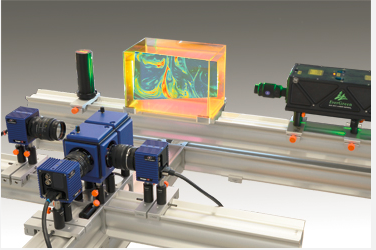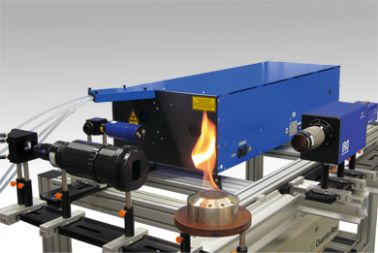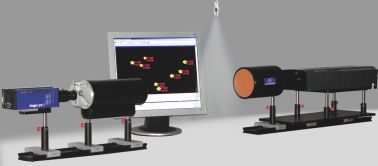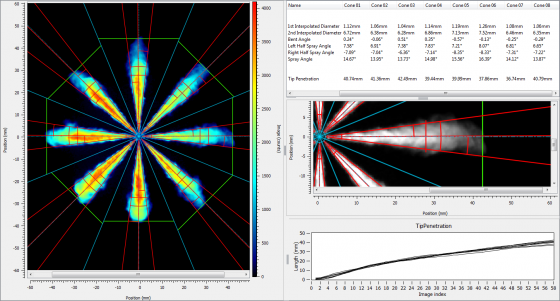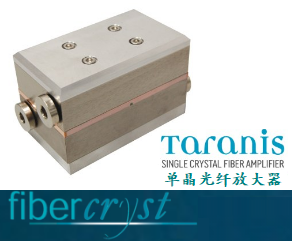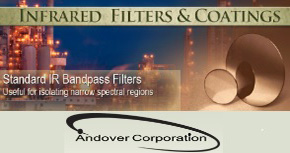公司简介
LaVision was founded in 1989 as a spin-off from Max Planck Institute and Laser Laboratory in Goettingen, Germany. LaVision cooperates with leading scientists, research institutions and companies around the globe. Among the major cooperation partners are the Laser Laboratory Goettingen, the University of Delft, German Aerospace Center (DLR), Technical University Darmstadt and the Karlsruhe Institute of Technology (KIT).
产品列表
FlowMaster
PIV/ PTV-systems
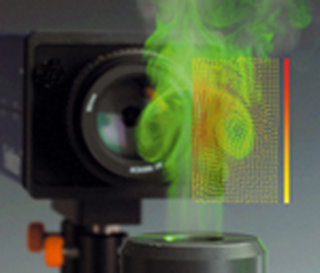
The LaVision FlowMaster system family evaluates three-dimensional velocity vector fields from scattered light patterns of particles or droplets seeded into the flow (liquid or gas). Techniques like Particle Image Velocimetry (PIV) and Particle Tracking Velocimetry (PTV) are supported. LaVision's FlowMaster PIV cameras can record two successive images within min. time <100 ns for ultrafast cross-correlation and speeds up to Mach 4. The PIV cameras offer highest sensitivity and allow the use of very small particles (or droplets). An image field of up to 29 million pixels combined with up to 16 bit dynamic range gives an unsurpassed spatial resolution. Programmable precise timing sequences in combination with flexible and speedy software evaluation complete the package.
Standard 2D-PIV (2D2C) measures two velocity components in a plane using a single CCD or sCMOS camera.
Stereo-PIV (2D3C) measures three velocity components in a plane using two cameras.
Time-resolved PIV measures two or three velocity components in a plane at high frame rates up to 25000 fps (frames per second) with full camera resolution.
Tomographic PIV (Tomo-PIV) measures three velocity components in a volume (3D3C) using two or more cameras.
Micro-PIV measures two or three velocity components of particle seeded flows with micron scale spatial resolution.
Applications
liquid and gas flow investigations in wind tunels, water channels, in-cylinder engines industrial flow systems, compressors, turbines, fans, pumps, Micro Electro Mechanical Systems (MEMS)
Information
velocity fields (strain, vorticity etc.)
flow visualization
System Features
self-calibration for 3D stereoscopic PIV eliminates calibration errors
beam delivery. articulated arms, compact sheet optics
particle seeder
general purpose synchronization device
online data storage, real-time data recording for many hours
data analysis on CPU and GPU
distributed computing on network PCs
Specials
underwater PIV setup for towing tanks with smart optical access
in-cylinder flow analysis with laser and camera endoscopes
————————————————————————————————————————————————————
FluidMaster
FluidMaster is a complete laser imaging system family for the quantitative visualization of thermal flows and mixing processes in fluids. Instantaneous concentration and temperature fields are measured with high spatial and temporal resolution.
Applications
investigation of fluid mixing, thermal flows and flow structures, flow visualization in wind tunnels and turbomachinery applications, air film cooling, hydrodynamics ... for further information see Applications in Fluid Mechanics
Information
quantitative visualisation of concentration and temperature fields in fluids
pH-imaging and degree of reactive mixing in liquids
gas density measurements in thermal flows
System Features
integrated turnkey laser imaging systems based on application matched best selection of laser and camera
complete hardware control using DaVis software
accurate hardware and signal calibration
most effective LIF excitation techniques
Rayleigh thermometry package for thermal gas flows
oxygen (O2)-LIF imaging module
Specials
3D-imaging setups
time resolved imaging, digital film recording
————————————————————————————————————————————————————
FlameMaster
LaVision's FlameMaster system family is designed to help the scientific and engineering community to find new concepts for the realization of more efficient and cleaner combustion devices.
3D Flame Imaging
Reconstructed time-averaged 3D OH* distribution in a premixed CH4 - air flame
Principle of tomographic flame imaging using a single camera:
An intensified CCD camera records the line-integrated projections of the OH* emission from 15 viewing angles of a premixed CH4-air flame featuring a strongly corrugated 3D-flame front. The tomographic reconstruction software module in DaVis generates from these 15 2D-images the mean volumetric OH* distribution of the flame.
————————————————————————————————————————————————————
EngineMaster
EngineMaster
Multi-functional laser imaging systems investigating all stages of internal combustion processes like fuel injection, air-fuel mixture formation, ignition, combustion and pollutant formation.
Applications
all kind of internal combustion phenomena:
fuel injection, air-fuel mixture preparation
in-cylinder temperature fields, ignition and flame propagation, pollutant and soot formation
... for further information see Applications in Engines
Information
liquid and vapor fuel concentration fields
local air/fuel ratios (lambda-maps)
in-cylinder temperature during mixture formation
localization of knock centers
flame front propagation
combustion species concentration (OH, NO, CH ...)
soot concentration and primary soot particle size
System Features
integrated turnkey laser imaging systems based on application matched best selection of laser and camera
complete hardware control using DaVis software
accurate hardware and signal calibration
predefined crank angle resolved measurements with cycle statistics
multi-functional engine synchronization interface:
crank angle decoder, engine simulator, trigger conditioner
Specials
endoscopes for keyhole imaging
high speed digital film recording of complete cycles
high speed imaging pyrometers
EngineMaster Sychronizer for injection, ignition control and others
EngineMaster inspex
The EngineMaster inspex product range has been designed to provide turnkey solutions for in-cylinder spray and combustion visualization. The systems include all necessary components: high resolution digital color cameras with imaging endoscope, endoscopic spray and background contour illumination, engine sealing inserts, synchronisation electronics and software for recording and visualization. Three different options are available providing different levels of performance up to fully crank angle resolved high speed imaging.
Applications
spray visualization: propagation, geometry, wall interaction (wetting)
on-set of ignition, misfire, flame propagation
combustion visualization
detection of soot formation sources, e.g. pool fire
System Features
direct visualization of in-cylinder combustion cycle
full engine synchronisation with advanced triggering features
crank angle synchronized recording (standard)
crank angle resolved multiple cycle recording (high speed)
minimally invasive endoscopic illumination and imaging
high transmission endoscopes
high resolution digital color cameras
engine adaptation including engine sealing sleeves
Endoscopic Imaging
Endoscopic Imaging is commonly used in flow field and combustion measurement for gas turbines, IC-engines and industrial processes.
IC-Engines
cylinder internal flow field
swirl and tumble
combustion monitoring
fuel distribution with LIF
air-fuel ratio with FARLIF
Gas turbines
flame structure
flame front diagnostics via OH self emission or OH-LIF
flow field
flame vibration analysis
Industrial Processes
mixing
spray drying
particle combustion
heat exchangers
————————————————————————————————————————————————————
ParticleMaster
LaVision's ParticleMaster system family is designed to simultaneously determine size and velocity of individual particles or droplets in fluids or multiphase flows. The imaging systems analyze various types of particle laden fluids and other two-phase flows with high spatial resolution. Data acquisition and on-line evaluation are performed with the versatile DaVis software.
Applications
investigation of droplet or particle size distributions in various applications such as spray atomization, bubbles, particle flows ... for more details see Applications for Particle Imaging
Information
simultaneous size, velocity and position of individual particles
velocity-size correlations
morphology and shape information
mass flux and number density
ensemble statistics, frequency plots and histograms
visualization of ligament formation, spray break-up and atomization
System Features
integrated turnkey particle imaging systems matching optimal selection of illumination and detection devices
complete hardware control and timing with versatile DaVis software
accurate hardware and size calibration
comprehensive on-line image evaluation and data processing
most accurate evaluation algorithms
hardware compatible with LaVision's PIV systems
Specials
high speed image recording to investigate transient processes
high efficient diffuser for speckle-free illumination
——————————————————————————————————————————————————
SprayMaster

LaVision's SprayMaster is a complete family of optical measurement systems designed for non-intrusive analysis of spray processes in many fields. Various applications require different system approaches: LaVision is offering predefined systems (see overview) and special customized systems to achieve the application-specific performance. The systems are easy to operate, fast and efficient measurement tools for R&D as well as quality control.
Applications
imaging of sprays and related processes:
fuel injectors, spray coating and drying processes
pharmaceutical, medical and paint spraysspray patternation
cone angle
mass distribution
Sauter Mean Diameter D32
evaporation
... for further information see Applications in Sprays
System Features
integrated and modular spray imaging systems based on
application matched best selection of light source and
camera systemcomplete hardware control using DaVis software
accurate hardware and signal calibration
robust system designs for industrial spray inspection applications
customized test protocols
Specials
fiber optics light delivery systems
simultaneous multi-parameter spray imaging:
droplet size, temperature, velocity and phase information
Quantitative Planar Droplet Sizing in Sprays
Since early 2000 LaVision provides a technique to measure the spatial distribution of averaged droplet size in a spray. The planar droplet sizing approach based on Laser Imaging produces 2D-resolved maps of Sauter Mean Diameter (D32) from spray images. Complementary to a pointwise measuring Phase Doppler Interferometer (PDI) the D32 technique reveals only averaged relative values, but instantaneously from a full plane.
Applications
fuel injectors (gasoline direct injection, Diesel)
gas turbines
spray cooling
pulsed and continuously running atomizers and spray nozzles
The planar droplet sizing technique uses Laser Induced Fluorescence (LIF) and Mie scattering, recorded at the same time. The 2-dimensional D32-maps are generated from the ratio of both signals. This technique is well-known, but tends to suffer from multiple scattering of the laser light within the spray cone.
Structured illumination with SLIPI improves spray imaging
LaVision now provides the improved SLIPI method using structured laser illumination, which overcomes the limitation from multiple light scattering and cleans up the images by removing image artifacts. 2-dimensional spray density and size maps will reveal the undistorted spatial structure with unsurpassed quality. The hollow cone spray shown in the picture now appears hollow, and the droplet size map matches well with pointwise recorded Phase Doppler data (PDI).
2-dimensional Sauter Mean Diameter (D32) map of a hollow cone spray with conventional imaging (left) and from cleaned up images with SLIPI (right).
Spray Plume and Pattern Geometry Analysis
LaVision’s SprayMaster Geometry package extracts spray plume morphology and geometry information from backlight and light sheet spray images. It replaces conventional patternation by an optical measurement.
Depending on the optical arrangement, the LaVision SprayMaster system obtains information about the spray plume shape and propagation (axial spray cuts) or the plume pattern (radial cuts). Analysis of multi-hole injectors (e.g. automotive fuel sprays) reveals geometry information from each individual spray cone separately.
Axial spray cuts: plume geometry and propagation
Multi-hole injectors
For Diesel injectors and multi-hole gasoline injectors it is necessary to get detailed information about the stability and uniformity of each single spray cone. The Geometry of each cone is processed individually to present information about the uniformity of the spray formation. Time resolved measurements of individual spray strokes allow to measure the shot-to-shot stability in time.
SprayMaster Geometry dialog
The SprayMaster Geometry package allows to arrange results presentations defined by the operator. Multiple windows can be arranged together in a view according to individual needs. If more space is needed on the screen, information can be spread overmultiple tabs. Integrated screenshots and movie generation allow to achieve reportable results with a minimum of user interaction. Multi-threading and multi-processor support drastically increases the computation speed. Changes made to the processing parameters are shown in real-time to give instant feedback to the operator.
————————————————————————————————————————————————————
StrainMaster
StrainMaster 2D/3D DIC
StrainMaster from LaVision is a state-of-the-art, non-intrusive optical tool for shape, strain and deformation analysis of solid, granular and liquid subjects. StrainMastercombines the most advanced Digital Image Correlation(DIC) algorithms with the highest quality hardware to provide a complete and easy to use device for materials analysis. StrainMaster is applicable across all industries investigating material behaviour and gives fast, highly accurate results via an easy to use PC based interface.
StrainMaster can be supplied as a complete turn-key system or as stand alone software for importing and processing images from an external source such as a Scanning Electron Microscope (SEM). The system offers a complete solution and data management system able to drive hardware, acquire images, process data, validate, and display or export information.
During image acquisition the powerful StrainMaster system is able to command pulsed lighting, automate translation stage movement, record analogue load data and synchronise with external (e.g. cyclic) events. The user is able to set up batch operations for multiple processing steps, and utilise the resources of networked PCs via a distributed processing system; all of which is included as standard.
A range of StrainMaster systems are available from portable field work machines to highly specialised lab versions. Any system can be tailored to suit your particular requirements, e.g. for use with one camera for 2D and two cameras for stereo (3D) analysis or as high speed system , and are appropriate for both industrial and academic applications across a range of subject areas.
Several upgrades are available to make the StrainMastersystem capable of multi-parameter measurements. For example PIV can be added to measure fluid-structure interaction, by simultaneously measuring structure deformation and airflows.
StrainMaster DVC
LaVision's state-of-the-art Digital Volume Correlation (DVC) software brings new depth to quantitative imaging analysis.DVC is not only capable of identifying defects and cracks before they are visible in the raw image, but it is also able to quantify the full volume strain distribution and actual magnitudes of the material displacements surrounding discontinuities. The level of information is extremely useful in validating Finite Element models of modern complex materials. Volume images can be imported into the software from a variety of sources such as:
X-Ray Computed Tomography
Magnetic Resonance Imaging (MRI)
Optical Coherence Tomography (OCT)
Confocal Microscopy
————————————————————————————————————————————————————
LaVision's camera systems
| CCD and ICCD cameras are the heart of the laser imaging systems offered by LaVision. Therefore, LaVision is continuously striving to offer the most appropriate cameras for our customer's application. All camera systems include camera head, control units, multiport TTL-I/O interface, PC and high performance software DaVis for image acquisition, processing and analysis. LaVision's DaVis software allows complete camera function control, synchronization with other devices and peripheral device activation. All software functions are programmable via LaVision's command language (CL). CL allows the automization of complete measurement sequences including data acquisition and processing up to final result presentation and peripheral device control. Application specific software modules are available. |
diesel spray injection | |
| High-speed imaging provides detailed insight into transient phenomena. LaVision offers a range of digital (ultra) high-speed cameras and light sources operating together under advanced synchronization concepts. High-speed imaging is under complete software control for device operation, image acquisition, processing and presentation. |
exposure time: 1µs, frame rate: 67 kHz |
——————————————————————————————————
DaVis - The Complete Software for Intelligent Imaging Applications

DaVis is the complete software for intelligent (laser) imaging applications for non-reactive and reactive flow fields, material surface imaging and tracking and (ultra) high speed imaging.
The software integration of the selected imaging system is achieved with flexible acquisition modes, customized DaVis software interfaces and application specific imaging packages.
DaVis features user selectable acquisition sequences with precise synchronization on ns-time scale of camera exposure, illumination and external event trigger. A huge range of imaging devices are under DaVis control.
The open nature of DaVis in combination with its macro programming language (CL-language) allows a fast adaptation of the imaging system to different measurement tasks ranging from sophisticated research to reliable industrial applications.
Flexible image acquisition modes, advanced image processing algorithms, intelligent storage and presentation of multi-dimensional image data as well as the software controlled operation of all implemented hardware are the key features of DaVis.
DaVis runs under Windows 7 (64 bit) and offers the familiar Windows interactive user interface. The online help in PDF manuals can be viewed with the preferred browser. LaVision's in-house software engineers continuously design new algorithms for processing and displaying acquired data and including new camera types, lasers and other hardware devices.
————————————————————————————————————————————————————
Sensor Systems
LaVision is offering optical sensor systems for the following applications:





